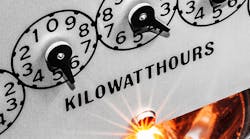After three decades in manufacturing, and one more decade spearheading continuous energy improvement programs, I’ve seen every form of energy waste under the sun: Air compressors that run 24-7, even when there’s no work going on at the plant. Leaks that go unnoticed for days, weeks and sometimes indefinitely. Used equipment that may have saved a few bucks on the sticker price but drives up energy use. Does any of this sound familiar to you?
Historically, lean manufacturing has not considered energy as a waste stream. However, with the rise of continuous energy improvement programs, manufacturers are discovering that energy can make a significant impact on your productivity and bottom line. I’ve seen manufacturers save, on average, 20% after they adopt a CEI program.
If you don’t yet have an energy management program, or can’t get your decision-makers to buy in, you can still find ways to move your plant in the right direction. Start small with these simple energy-saving opportunities to cut your utility costs today.
Identify, and Fix, Compressed Air Leaks
We’ve all heard of the “Dirty 30” -- the last 30 feet of your line, where all the compressed air leaks happen. For nearly every manufacturing facility, compressed air leaks are the top culprit for energy waste. However, plant managers who are busy running teams and overseeing production lines don’t often realize just how costly a compressed air leak can be. That one-quarter inch leak at 10 psi at 7 cents per kWh, for instance, could cost you $11,735 per year. On the other hand, if you reduce compressed air pressure by just 2 psi, you can cut your electrical use by 1% overall.
Ed Birch
One of our clients used shield gas to achieve a higher quality weld. When the organization started to pay attention to the leaks with its shield gas, something amazing happened: Their welding improved so much that they were finally able to use the right amount of gas, rather than too much. Their use of shield gas dropped by an entire truckload per month.
Make it a habit to identify leaks, repair them and ensure they’re fixed with an ultrasonic leak tester. A general rule of thumb is that plants should aim for an 80 psi compressed air target. Also, remember that your equipment isn’t measured for quality based on whether it leaks, so all new gear needs to be checked to make sure it’s leak-free.
Streamline Idle Time and Changeovers
Idle time such as downtime and changeovers is one of the top energy wasters in today’s manufacturing plants. I’ve seen several instances where air compressors were running 24/7, and over weekends, to heat a facility’s space. By simply reviewing the compressor operating schedule and only running the machine when needed, it saved one plant 182,306 kWh -- or $18,230.
Start by determining your cost for idle time. Then, set a goal to reduce this cost and prioritize the equipment that provides the most energy savings. With one chemical processor, we worked with the sales departments to schedule product/pellet sizes and run durations. This allowed us to mix products by size and avoid clearing the entire production line -- in turn, minimizing rework and changeover downtime. The result? Less energy waste, more capacity and improved productivity.
Beware of Used Equipment
If you’ve bought used equipment, you probably walked away from your purchase thinking you got a great deal. But you probably didn’t take into account energy cost. When including energy waste and use levels, it’s sometimes more cost effective to buy a new piece of equipment that’s better designed and produces better quality.
Case in point: One manufacturer used a hot oil bath to heat treat its own chain saw chain. They purchased a used bath, which was originally designed for much larger parts. When we measured the volume of oil in each bath we discovered each tub had significantly more oil than the original design specification, and the oil temperature was 60 degrees higher than the standard operating procedure. Needless to say, the low sticker price on the used equipment wasn’t such a good deal when you looked at this energy waste.
Ask the “Energy Question”
When you’re trying to implement energy improvements, the worst thing to do is tell your organization that you’re starting a new initiative and seek revolutionary ideas. Don’t reinvent the wheel. Instead, look at one of your successful programs and use that as a blueprint for your energy program.
If you have a lean manufacturing program, make energy an agenda item at your kaizen event. Ask the “energy question.” Integrate energy into your existing mapping process, and think about what it would look like to replace the words “safety” or “quality” with “energy” in your current programs.
At the end of the day, the best way to save energy is to simply do it. One plant recently implemented a water reduction program called “Just Git ‘er Done” and achieved remarkable results by just saying they were going to get the job done. No big money spent, no formal program, but lots of signs and reader boards. This focused effort, improved energy usage driven by pumping water and saved more than 1 million gallons of water.
Talk about a boost for your bottom line. Just Git ‘er Done!
A seasoned manufacturing executive, Ed Birch’s expertise in organization change is rarely found in the energy management sector. Birch’s corporate turnaround and organizational change initiatives help Strategic Energy Group clients achieve persistent, organizationwide energy savings. Birch has spearheaded SEG’s continuous energy improvement programs for over 200 industrial and commercial organizations in North America. Prior to SEG, Birch served as Chief Operations Officer for Unicep Packaging and Litehouse Salad Dressing, Inc. Through these leadership roles, he implemented lean manufacturing strategies and instituted ISO standards while overseeing daily operations and logistics.





